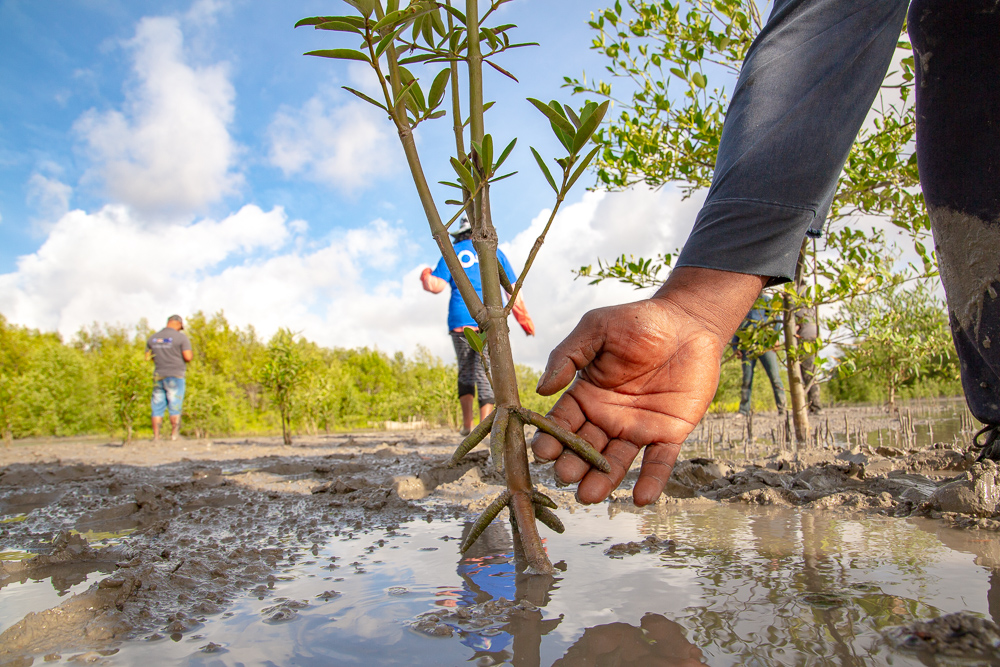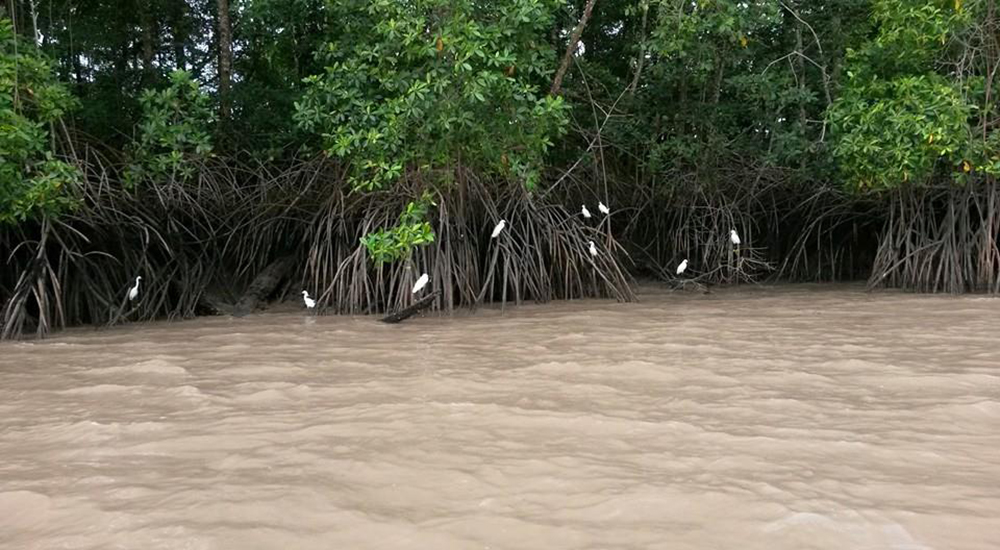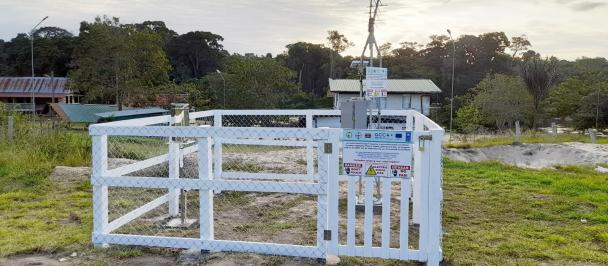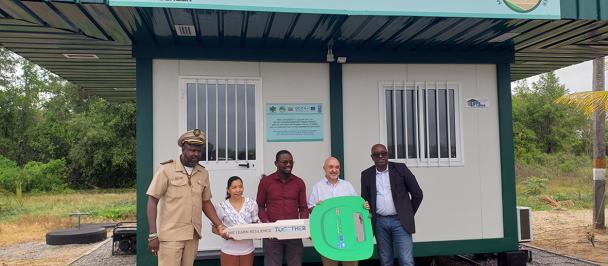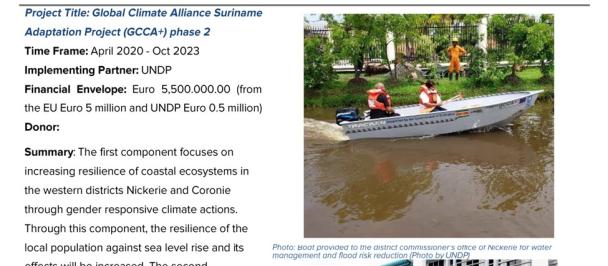The planting activities by the Nickerie River. David, a volunteer, showcases the roots of mangrove plants that were planted as part of a Global Climate Change Alliance Plus (GCCA+) Mangrove Rehabilitation project in Suriname. Photo Credit: © GCCA+/EU 2020. Photo taken by Harvey Lisse. February, 2020
The United Nations declared May 22 as World Biodiversity Day. This, in order to increase understanding and awareness regarding biodiversity issues. The word Biodiversity is derived from biological diversity and can be described a as all the different kinds of life you find in one area. It is the variety of animals, plants, fungi, and even microorganisms like bacteria that are part of our natural world. Each of these species and organisms work together in ecosystems, to maintain balance and support life. All life organisms on earth are interconnected, in an interdependent global ecosystem in which they all have their own role.
For World Biodiversity Day 2021, the theme is: “We are part of the solution.” From nature-based solutions to climate, health issues, food and water security and sustainable livelihoods, biodiversity is the foundation upon which we can build back better1.
Biodiversity is important for people and nature. It provides countless services and products to society and the economy and is indispensable to human existence on earth. Examples of so-called 'ecosystem services' are pollination of food crops by insects, wood formation by trees, water purification by wetlands, but also natural beauty that you can experience outside.
Unfortunately, climate change affects natural systems, and biodiversity is threatened by climate change in many parts of the world. More biodiversity is being lost and ecosystems are deteriorating, as a result that we no longer can rely on their essential services.
Climate change is also a threat to our Mangroves. Mangroves are a very important part of our biodiversity as they make an important contribution to ecosystem services such as providing a nursery for fish, forest by-products, eco-tourism opportunities, water purification, and they also play a role in regulating services such as coastal protection and carbon storage.
Due to their root structure, these areas are also called the nurseries of the ocean. Many species of fish, birds, reptiles, and amphibians live in these areas. Humans in turn depend on fish, shrimp and certain bird species that live in these areas for nutrition or economic activity2.
Mangrove area in Commewijne river. The variety of animals and plants that are part of our natural world. They work together in ecosystems, to maintain balance and support life. Photo credit: R. Kasandikromo, May 2018
Within the Global Climate Change Alliance Suriname Adaptation Project (GCCA + Project), funded by the European Union (EU), in partnership with United Nations Development Programme (UNDP), the “Setting up a mangrove biodiversity monitoring system” project, coordinated by the Foundation for Forest Management and Production Control (SBB), in collaboration with the National Herbarium (BBS), the Center for Agricultural Research Suriname (CELOS), the National Zoological Collection Suriname (NZCS) and the Nature Conservation Division (NB), data was acquired and analyzed from sampling locations. The data provided insight into the state of the mangrove forest cover in Suriname and its spatial development over recent decades as well as the state of biodiversity therein and its carbon stocking capacity. We can conclude from the information obtained, that over the period 1988 – 2018 that four (4) districts bordering the sea; Commewijne, Nickerie, Coronie and Paramaribo have experienced significant net cover losses in mangrove. Coastal erosion and human activities being the main drivers 3.
Due to the more frequent occurrence of extreme weather conditions, resulting in coastal erosion, we are losing the mangrove forest. We will increasingly face food shortages, drinking water shortages, warmer weather, and flooding, which will affect people, animals, and plants. Many endangered animal and plant species live in areas suffering from the effects of climate change. Animals and plants cannot adapt quickly enough to the rapid rate of climate change. If we do not take climate responsive actions, part of all animal and plant species will go extinct 4.
To help mitigate the effects of climate change, affecting our biodiversity, the GCCA + Project, supported the Mangrove Conservation and Rehabilitation project in Bering Hole in the Nickerie district, Suriname, together with the local community of Nickerie and the Anton De Kom University Suriname (ADEK University Suriname) in May 2017.
The Bering Hole area, which is part of the Bigi Pan, a multi-use management area, started because on the one hand, the coast in this area is increasingly suffering from erosion due to the waves of the sea. On the other hand, sea water considerably penetrates inland during high tide, and during low tide the water draws back too far, resulting in less fish to catch, less birds, less tourists and ultimately in less income for the population depending on this ecosystem. The threat is that if that part of Bigi Pan erodes away, Nieuw Nickerie situated on left bank of the Nickerie river will directly lie on the Atlantic Ocean. The existing infrastructure along the Nickerie River is not built to withstand constant waves of the ocean and it will be a challenge to preserve Nieuw Nickerie. Together with local partners, of Sustainable Management of Natural Resources, the Master of Science Course of the ADEK University Suriname, the GCCA + Project, developed activities to promote the rehabilitation and restoration of the mangrove ecosystems in that area by building sediment traps to reduce erosion and replanting of mangroves. In addition, the awareness of the local youth in Nickerie was increased resulting in a higher appreciation of the services of mangrove ecosystems among the population. Information on enhancement of sustainable use of the resources provided by the system was provided to the local community; tour operators, fishermen and hunters5.
The GCCA+ project is committed to mangrove conservation because, not only do trees provide a habitat for animal and plant species, but they also purify the air we breathe, restore the ozone layer, and absorb and store carbon in their wood.
The only thing we can do, is to adapt to the effects of climate change, which is causing significant cover losses in mangrove due to coastal erosion and be aware about the services of mangrove ecosystems and sustainable utilization of ecosystems. Creating awareness should start with children by engaging them in a creative way. Constantly make the community aware that there is danger if we do not work together on a sustainable solution for the conservation of these areas, because unfortunately these areas are also removed to build houses or to breed fish and shrimp in large ponds of aquaculture.
Climate change is harmful to biodiversity and is now known to be one of the causes of biodiversity loss. At the same time, the climate will change even faster if biodiversity and ecosystems are not efficiently protected with the help of people.
In line with this, the message conveyed by the Secretary-General of the United Nations, Mr. António Guterres is
"We need to protect nature, restore ecosystems and balance our relationship with the planet."
References:
- International Day for Biological Diversity UNITED NATIONS https://www.un.org/en/observances/biological-diversity-day
- Europese Commissie/ Natuur en Biodiversiteit
- FINAL REPORT: Mangrove Biodiversity Monitoring System
- https://www.eea.europa.eu/nl/highlights/steeds-ernstiger-risicos-voor-ecosystemen
- GCCA+ Project Documentation 2019: Results & Reflections towards a Climate Resilient Suriname

 Locations
Locations